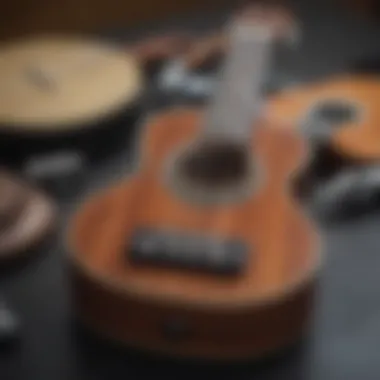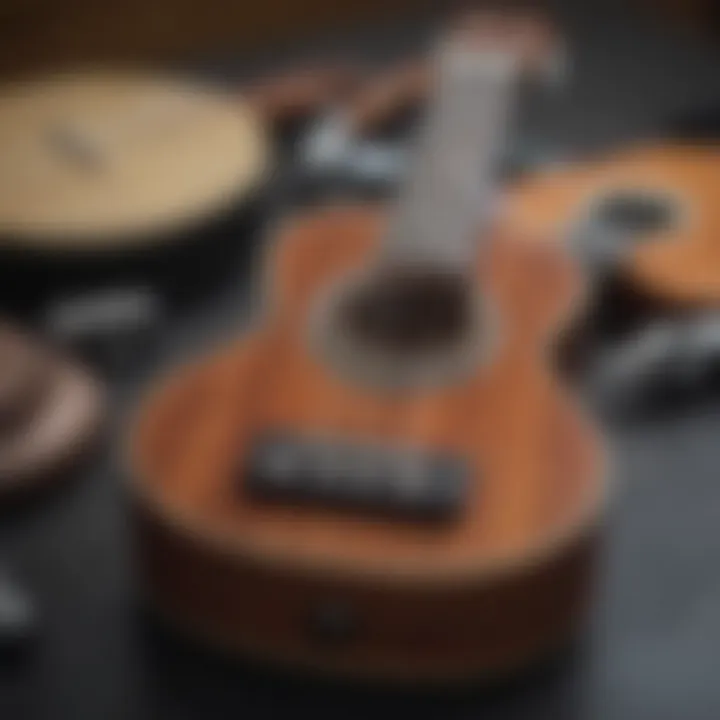Mastering Standard Ukulele Tuning: A Detailed Guide


Intro
Tuning a ukulele may seem like a simple task, but it’s the cornerstone of creating beautiful music. For those who strum, pluck, or pick, understanding standard tuning is vital. This article dives into the full world of standard ukulele tuning, exploring its significance, methods, advantages, and the various tools available for enthusiasts at any skill level.
Many players, from beginners to seasoned pros, can find themselves at crossroads: what tuning brings out the best in their instrument? G-C-E-A, the standard tuning most widely accepted, is more than a set of notes. It’s a pathway to musical expression, ensuring the strings resonate in harmony. By the time you finish reading, you will have a thorough awareness of standard tuning and how it informs your musical capabilities across different genres. Whether you’re pondering the best tuning techniques or grappling with common tuning issues, this exploration will equip you with the insights to elevate your playing.
Understanding the Ukulele
To fully appreciate the nuances of standard tuning for the ukulele, it's essential to have a firm grasp of the instrument itself. The ukulele is not just a stringed instrument; it embodies a musical tradition that brings joy and creativity to countless players worldwide. Understanding its structure, features, and types is pivotal in grasping the significance of tuning. A well-tuned ukulele not only enhances playability but also elevates the musical experience, making it crucial for both beginners and experienced players.
Historical Context
The ukulele traces its origins back to the 19th century, specifically to the islands of Hawaii. It was inspired by the Portuguese braguinha, brought to Hawaii by immigrants. The ukulele, which means "jumping flea" in Hawaiian, quickly gained popularity. Its unique sound and compact size made it a beloved instrument, spreading far beyond Hawaii's shores and finding a place in folk music globally.
The historical context of the ukulele is important as it reflects cultural exchange and adaptation. The ukulele seamlessly blends various musical traditions, which gives it a unique character. Understanding this history not only enriches one’s appreciation for the instrument but also informs the way it is tuned and played in different genres today.
Types of Ukuleles
Ukuleles come in several types, each with its distinct characteristics and tonal qualities. Choosing the right type can significantly influence how one interacts with the instrument. Let’s dive into the different types:
Soprano
The soprano ukulele is often considered the standard ukulele size. It's roughly 21 inches long and has a bright, cheerful tone. This size is best for beginner players as it is lightweight and fits comfortably in the hands of most adults and children alike. The soprano ukulele typically uses standard G-C-E-A tuning, allowing players to dive right into many popular songs.
One key feature is its high pitch, which can add a joyful whimsy to any tune. However, its range is somewhat limited compared to larger types.
Concert
The concert ukulele, measuring about 23 inches, offers a bit more depth and volume compared to its soprano counterpart. It retains the same tuning of G-C-E-A but produces a richer sound, making it favorable for players who want both portability and a warmer tone.
A unique characteristic of the concert ukulele is its extended fretboard, which allows for easier access to higher notes. Some players find this more comfortable, especially when playing intricate melodies. The concert ukulele strikes a balance between sound quality and playability.
Tenor
The tenor ukulele is larger still, typically around 26 inches long, and it has a deeper tone that appeals to many intermediate to advanced players. This size is often praised for its volume and resonance, making it a go-to choice for solo performances.
The tenor can also be tuned to G-C-E-A, but it can also accommodate alternative tunings, which adds versatility. However, its larger size may not suit everyone, particularly those with smaller hands or those who prioritize compactness.
Baritone
The baritone ukulele is the largest of the common types, reaching about 30 inches in length. It produces a sound more akin to that of a guitar, as it is typically tuned D-G-B-E, unlike the other ukuleles. This makes it a popular choice for guitarists who want to explore the ukulele's charms.
While the baritone ukulele offers a rich, resonant tone, it might not be ideal for those who wish to maintain the traditional ukulele sound. Its tuning differences can also lead to a steeper learning curve for beginners who are more familiar with standard ukulele songs.
In summary, appreciating these different ukulele types enhances the understanding of their respective tuning needs and the overall musical experience they offer, reinforcing the importance of finding the right instrument for one’s personal style.
The Concept of Tuning
When stepping into the world of ukulele playing, understanding tuning is one of the foundational aspects. Tuning ain’t just about making your instrument sound pretty; it directly influences how good the music feels. For novices and seasoned players alike, grasping the concept of tuning can lift one’s overall performance and enjoyment of music. The ukulele, with its warm and inviting tone, carries nuances that can either shine through or get lost in a poorly tuned instrument.
Definition of Tuning
In simple terms, tuning refers to the adjustment of the strings on an instrument to achieve the desired pitches. For the ukulele, standard tuning is commonly set to G (fourth string), C (third string), E (second string), and A (first string), forming the sequence known as G-C-E-A. Each note aligns with a specific frequency, ensuring that when played with other instruments or within a song, the sound harmonizes perfectly. You might think of tuning as setting the stage for a performance: without the right adjustments, even the most talented performers can be drowned out by an off-key performance.
Significance of Proper Tuning
Proper tuning has more significance than just sounding pleasant. Here’s why it matters:
- Musical Collaboration: When jamming with others, whether it's a casual group of friends or a performance setting, being in tune means everyone is contributing to the same musical tapestry. If one ukulele is off-key, the fabric becomes frayed and uncomfortable to listen to.
- Skill Development: Learning to play in tune enhances ear training, which is crucial for any musician. By developing the ability to identify pitches and adjustments, a player improves they’re overall musicality.
- Instrument Longevity: Regularly tuning your ukulele and maintaining proper pitch helps to manage string strength and health. Strings that are overly tightened or loosened can wear out faster, leading to unnecessary replacements. Proper tension maintains quality and prolongs their lifespan.
"A finely tuned instrument is like a well-oiled machine; it can make or break the performance."
As one dives deeper into the craft, it becomes clear that tuning is not just a task to check off. It’s an ongoing dialogue between the player and the instrument, essential for any successful musical journey. Overall, the concept of tuning intertwines with every chord struck, every note played, and every melody shared. Understanding this concept fully can elevate an average ukulele session into an extraordinary musical experience.
Standard Tuning Explained


Understanding standard tuning is essential for anyone picking up a ukulele, whether you’re a newbie twanging at your first chords or a seasoned player looking to refine your skills. This section aims to shed light on why the G-C-E-A tuning is not just an arbitrary choice but also a practical approach that enhances playability and musical expression. The magic of standard tuning lies in its ability to create a predictable sonic landscape, making it easier for players to learn songs and collaborate with others.
Standard Tuning Overview
G-C-E-A Sequence
The foundation of standard ukulele tuning revolves around the G-C-E-A sequence. At first glance, it may seem like a jumble of letters, but each note corresponds beautifully with the instrument's structure. Let’s dive deeper into this sequence and explore its impact on the ukulele's sound and playability.
- G: This is the top string, the highest pitch. It's a bright string that gives the ukulele its signature cheerful tone.
- C: The second string is tuned to C, which is effectively the bass note that grounds the sound.
- E: This third string complements the G and C, producing a rich, warm sound that balances out the higher pitches.
- A: Finally, the bottom string gives a lively touch to the overall arrangement.
This G-C-E-A tuning is immensely popular not just for its sound but for its accessibility. With this tuning, a player can easily learn basic chords and transition smoothly between them. Moreover, many songs are composed with these chords in mind, making it easier to join in on jam sessions or play along with recordings.
One unique feature of the G-C-E-A sequence is that it invites harmonic complexity; players can create diverse chord voicings that dance off each other. However, a not-so-overlooked disadvantage comes in when players decide to experiment with different tunings. The versatility becomes a tad cumbersome if you constantly shift between alternate tunings, as it may confuse your sense of chords and song structures. Nonetheless, for beginners and seasoned musicians alike, starting with G-C-E-A is a practical approach that fosters confidence and skill development.
Resonance and Sound Quality
The resonance and sound quality of a ukulele tuned to G-C-E-A is a defining trait of its appeal. Unlike heavier string instruments, the ukulele produces a bright and chirpy sound, bringing a sense of joy to songs.
The kind of strings you select can further influence this resonant quality. Nylon strings, which are common in standard tuning setups, give a warm and mellow tone, whereas fluorocarbon strings might deliver a clearer, more punchy sound.
- Resonance: When tuned properly, the ukulele resonates beautifully. Each note blends well with the others, creating a harmonic balance that allows for strumming and fingerpicking alike. The vibrations travel through the body of the instrument, enhancing the overall sound quality.
- Sound Quality: Players often notice a noticeable difference when switching to standard tuning from other options. G-C-E-A allows for bright chord progressions that are favored in pop, folk, and Hawaiian music. This tuning encapsulates the spirit of the ukulele—a light, breezy sound that reflects carefree vibes.
In summary, the G-C-E-A tuning is the lifeblood of cultivating the ukulele's identity. Familiarizing yourself with this sound can unlock avenues for musical creativity and expression. If you maintain your instrument properly and engage with the instrument faithfully, the joy that comes from its resonance can be a profound experience.
Tuning Techniques
Tuning techniques play a pivotal role in the world of ukulele music, ensuring that your instrument sounds harmonious and clear. When you're strumming along to your favorite tunes or crafting your own melodies, the last thing you want is a rogue note that throws everything off-kilter. Proper tuning is crucial not just for achieving the right pitch, but also for maximizing the resonance and tonal quality of your ukulele.
Engaging with proper tuning methods allows players to adapt to various musical genres while ensuring uniformity in sound. This is particularly valuable for those who frequently perform with others or wish to play along with recorded music. With the right techniques, players can expect clarity in their chords and a more enjoyable playing experience overall.
Tuning with a Tuner
Using a tuner is one of the most straightforward methods for ensuring your ukulele is in standard tuning. Tuner devices, both digital and analog, provide a visual representation of pitch and can guide you to adjust your strings accordingly. The main advantage of using a tuner is its accuracy; it can catch even the slightest deviations in pitch that might be missed by the ear.
Here’s how to tune your ukulele with a tuner:
- Power on the tuner and select the appropriate mode for your ukulele.
- Pluck each string one by one while observing the reading on the screen or indicator.
- If the tuner signals that your string is flat (lower pitch), tighten the tuning peg. If it’s sharp (higher pitch), loosen it.
- Repeat this for all four strings and double-check to ensure that everything is in order.
The digital tuners have become a common choice because they are portable and often feature a clip-on design, which makes for easy use on-the-go. For those who prefer the traditional route, analog tuners can offer vintage charm and simplicity.
Using a Pitch Pipe
For those who appreciate a more tactile approach, a pitch pipe can be a handy tool. This small device emits a specific pitch for each string when you blow into it. It’s an old-school method but still carries its weight in effectiveness. While it might not be as precise as digital tuners, many musicians favor the pitch pipe for its ease of use and portability.
To tune your ukulele using a pitch pipe, follow these steps:
- Identify the tuning notes, which correspond to G, C, E, and A for the standard tuning.
- Play the note on the pitch pipe that you want to match to your string.
- Adjust your ukulele string accordingly until it matches the sound from the pitch pipe. This may take a bit of practice, but it enhances your ability to discern pitch differences.
This method fosters an intimate connection to the music itself, as it encourages players to develop their aural skills over time.
By Ear Method
Finally, there’s the renowned method of tuning by ear, which many seasoned musicians advocate for. This technique may take some time to perfect but can be highly rewarding. It hinges on your ability to listen intently and recognize pitch relationships between strings, often referred to as harmonics.
Here’s a simple guide to tuning by ear:
- Start by tuning the A string to a reference tone, either from a piano or a pitch pipe.
- Adjust the other strings by forming perfect intervals with the A string. For instance, the C string should be tuned two frets higher than the open A.
- Continue adjusting each string, listening for the desired harmony and ensuring they sound cohesive.
While it may seem daunting at first, tuning by ear builds your overall musicality and sharpens your listening skills. It grants you independence from devices, allowing you to tune your guitar on the fly when a tuner is not handy.
"The sound of a well-tuned ukulele can be the sweetest symphony, resonating through the heart and soul of the musician."
Advanced Tuning Options
Diving into the water of standard ukulele tuning reveals not only the common G-C-E-A configuration but also opens the door to advanced tuning options. These alternative methods and styles expand the sonic capabilities of the instrument, allowing musicians to go beyond basic chords and delve into a world of creative expression. This section examines key elements of advanced tunings, their benefits, and important considerations for players looking to enhance their music.


Alternative Tunings
Aquila Tuning
Aquila tuning is a popular choice among ukulele players seeking a slightly different flavor in their sound. This specific tuning uses Aquila strings, which are made from a synthetic material designed to mimic the warmth and tonal characteristics of gut strings. One of the standout features of Aquila tuning is its emphasis on clarity and projection. The warmer tones can give a fuller sound, adding richness to performances.
For those looking to step beyond standard tuning, Aquila tuning serves as a beneficial option. Its unique string material provides durability while maintaining excellent intonation. However, players should be aware that the feel of these strings can be altogether different from traditional nylon, which some might find less comfortable at first. Still, the melodic enhancement it brings often outweighs the transitional challenges, leading to deeper artistic exploration.
Low G Tuning
Another notable alternative is Low G tuning. In this setup, the fourth string is tuned down to a low G instead of the standard high G. This change introduces a deeper bass and increases the instrument's tonal range. Many players appreciate Low G tuning for its ability to access a wider variety of musical patterns, especially in fingerstyle playing.
The advantage of Low G tuning lies in the added harmonic depth it delivers. It not only supports more complex arrangements but also complements genres that thrive on melody and bass interplay. However, the transition to Low G might require some adjustments, as the positioning of notes will vary compared to standard tuning. Nonetheless, for those adventurous enough to embrace the challenge, it opens a world of creative possibilities.
Genre-Specific Tunings
Jazz
Jazz is a genre that thrives on improvisation and harmony. Ukulele players delving into jazz often find that adapting their tuning can lead to a more complex and rich musical experience. Jazz tunings often incorporate extended chords and altered tones, allowing musicians to exploit the harmonic structure in their playing. This kind of flexibility is vital for jazz, where chord progressions can change rapidly.
Utilizing genre-specific tunings not only enhances a player’s versatility but also invites them to experiment, setting a foundation for lively performances. In jazz, the creative use of a variety of tunings can spark innovative solos and arrangements. However, it does require a solid understanding of chord structures, which can be a bit daunting.
Blues
Blues music has its roots in emotional expression, and specific tunings can amplify this sentiment. Players often employ Open G or Open D tunings, which simplifies certain chord shapes while adding unique tonal qualities. This setup also allows for slide guitar techniques, which are prominently featured in blues.
What makes blues tuning particularly appealing is how it encourages storytelling through music. It gives players the tools to convey deep emotions, using the ukulele as their voice. However, transitioning from standard tuning to genre-specific setups can be a learning curve, making practice essential to hit those soulful notes.
Classical
Lastly, classical music on the ukulele can take advantage of fingerstyle techniques and intricate compositions. Tuning to a more traditional classical setup, like tuning an octave higher than standard, allows for complex arrangements reminiscent of classical guitar pieces. This approach enhances the melodic and harmonic features of this repertoire.
The classical ukulele often requires a different playing technique, focusing on precision and nuance. The unique feature here is not just the tuning, but the discipline it demands from the player, paving the way for greater musical artistry. Adapting to classical tuning will certainly be a challenge, but for those willing to invest the time, the reward is a rich and fulfilling playing experience.
Technological Advancements in Tuning
In today’s fast-paced world, technology has a way of transforming old practices, and tuning a ukulele is no exception. These advancements have made it easier for both novice players and seasoned musicians to achieve precise tuning quickly. Gone are the days of relying solely on the traditional methods that required a trained ear, as now there are various tools at our fingertips that offer advantages in consistency and accuracy. This section will highlight two major technological innovations that have redefined how we approach the standard tuning of ukuleles: digital tuners and mobile apps.
Digital Tuners
Digital tuners have become a staple for many musicians, providing an efficient way to house accurate pitches in a user-friendly device. These gadgets work on the principle of pitch detection. When a string is plucked, the tuner picks up the vibration and identifies the note being played. It then displays this information, often with a visual indicator that tells you whether the string is sharp, flat, or perfectly in tune.
The ease of use is remarkable. Simply plug in your ukulele or use the built-in microphone to detect string vibrations. The ease with which one can achieve a perfect G-C-E-A tuning sequence is appealing, especially for those who might struggle with by-ear methods.
Some notable features of digital tuners include:
- Calibration Options: Players can adjust the pitch reference to suit different musical settings.
- Various Modes: Many tuners offer modes for different instruments, making them versatile.
- Compact Design: Most tuners are small and portable, making them easy to carry along for lessons or jam sessions.
In summary, digital tuners excellently bridge the gap between traditional tuning techniques and modern technology, simplifying the tuning process significantly.
Mobile Apps
Another significant breakthrough lies in the adaptation of tuning functionalities into mobile applications. With smartphones practically glued to our hands, it’s no wonder that apps have emerged as one of the most accessible tools for tuning instruments. These tuning apps leverage the built-in microphone of smartphones to detect pitches, mirroring the functions of digital tuners.
Some major benefits of using mobile apps include:
- User-Friendly Interface: Most apps are designed with intuitive interfaces, allowing for easy navigation.
- Instant Updates: Developers frequently update these apps to improve functionalities and features.
- Community Engagement: Many apps also offer community features, where users can share tips, ask questions, and discuss tuning challenges.
There are a plethora of available choices, like Tuner by Pano and GuitarTuna, and each of these alternatives often include additional features, such as metronomes and chord libraries.
"In a world where every second counts, turning to technology for tuning transforms an essential aspect of playing the ukulele into a quick and engaging experience."
Benefits of Standard Tuning
Standard tuning of the ukulele brings to the table a range of benefits that significantly enhance both the player's experience and overall performance. When musicians, especially beginners, dive into learning this instrument, having a solid foundation in standard tuning becomes vital. It sets the tone, quite literally, for how they will progress and enjoy their ukulele journey.


One of the most noteworthy advantages of standard tuning is that it streamlines the learning process. With the strings tuned to G-C-E-A, players can easily match their playing with instructional materials, such as sheet music and online tutorials. Most songs and chord charts are crafted with this standard tuning in mind. This compatibility can't be understated, as novice players often find themselves overwhelmed by the vast array of resources available. Having a consistent starting point makes learning easier, less frustrating, and ultimately more enjoyable.
Another factor to consider is the delightful sound quality that standard tuning brings. Each string is precisely pitched, which contributes to a harmonious tone that is particularly appealing in this small instrument. You may have noticed that when players strum their first chords with precision, the sweet sounds resonate beautifully, whether it’s at a beach gathering or a quiet evening at home. This resonance not only enriches their playing but also encourages a sense of accomplishment and motivation.
"Tuning your ukulele to G-C-E-A is like following a map—it directs you to the melodies waiting to be explored."
Ease of Learning
When talking about ukulele, ease of learning is one of the most attractive aspects of engaging with this instrument. Standard tuning simplifies the chord structure, meaning that beginners can grasp the basic chords more quickly. For instance, learning to play a C major chord in G-C-E-A tuning involves placing just one finger. This simplicity allows players to jump right into song playing, which can be incredibly encouraging for young learners or those picking it up later in life.
Moreover, standard tuning helps to establish muscle memory. As learners frequently return to familiar chords, they can create a strong physical connection to their playing. It becomes less about memorizing and more about proficiency. So, the next time you reach for your ukulele, those chord shapes will flow more naturally from your fingers, and you won't be searching for the right notes as if you're looking for a needle in a haystack.
Compatibility with Songs
Another feather in the cap of standard tuning is its compatibility with a vast number of songs spanning various genres. This universality opens doors for players to try their hand at anything from classic pop hits to heartfelt folk tunes. Want to strum along to "Somewhere Over the Rainbow" or an upbeat tune from Jason Mraz? As long as you’re tuned to G-C-E-A, you can find a wealth of resources and play along without needing complex adjustments.
Additionally, this standardization means that community resources are plentiful. From chord charts available on platforms like Reddit to instructional videos that cater directly to this tuning, players can tap into an ocean of content without the worry of tuning mismatches. It creates a shared language among players, fostering collaboration and camaraderie, whether at jam sessions or informal meetups.
In summary, the benefits of standard tuning resonate louder than ever in the ukulele community. The ease of learning and compatibility with songs fosters an engaging and fulfilling experience for players of all levels, encouraging continued exploration and enjoyment of this beloved instrument.
Common Tuning Issues
When we talk about the standard tuning of a ukulele, it’s not all smooth sailing. Various factors can cause your strings to go a bit haywire, and understanding these common tuning issues can make all the difference in maintaining a sweet sound. Music is all about consistency, and even the slightest change can throw off your performance. Let's delve into some of these issues to understand their implications and how to address them.
String Stretching
One of the most common culprits in tuning problems is string stretching. When you first string your ukulele or replace old strings, they have this annoying habit of stretching. Just like a new rubber band, they require some time to get used to their new environment. Initially, they might sound sharp or out of tune, and every time you play, they can slightly slip out of tune.
To tackle this issue, it helps to play your instrument regularly. The more your strings vibrate, the more they'll settle into place. Additionally, gently tugging on each string after tuning can expedite the process before you start jamming. Routine tuning before playing is also wise, as it ensures that you’re starting on the right foot.
"Tuning isn’t just a one-time task; it’s a crucial part of your playing ritual."
Environmental Factors
Weather can be a sneaky agent in affecting your ukulele’s performance. Two major elements to keep an eye on are humidity and temperature. Both can cause wood to expand or contract, leading to tuning issues.
Humidity
Humidity is particularly significant as it influences wood moisture. A higher humidity level can make the wood swell, while lower humidity can cause it to dry out and shrink. This means that when you step into a humid room, your ukulele might suddenly sound a bit off.
In this article, humidity is beneficial to acknowledge because it can easily impact tuning. Too much moisture can lead to warped necks or buzzing frets, while too little can create the opposite problems. Understanding your environment can help you adjust your playing conditions effectively.
Temperature
Temperature changes are almost always at play. If the air heats up, materials tend to expand, which can alter string tension and pitch. Conversely, when the temperature drops, your strings might tighten, resulting in a sharper sound. This aspect of temperature deserves attention as it directly correlates with how your ukulele will sound under varying conditions.
Being aware of your surroundings allows you to prepare for these fluctuations. For example, keeping your ukulele in a temperature-stable case before a performance can help maintain stability in tuning, preventing any unpleasant surprises when you strum the first chord.
Maintaining Tuning Stability
Finally, it’s crucial to focus on maintaining tuning stability throughout your playing session. Regular checks, especially in changing environments, will keep your sound true. If you notice strings slipping out of tune, it may be time to invest in quality strings or consider a ukulele with better tuning pegs. Consistency is what makes a great performance shine, and a little vigilance can go a long way.
Culmination
In wrapping up our journey through the world of standard ukulele tuning, it's vital to highlight the significance of the insights we've explored. The topic of standard tuning is not just a technicality for players; it is the backbone of successful music-making on the ukulele. This article navigated the essential elements of tuning, shedding light on techniques, tools, and the reasons behind the widespread G-C-E-A standard.
Recap of Key Points
Throughout the article, we’ve covered several essential aspects:
- Understanding Standard Tuning: The G-C-E-A sequence is what allows for a harmony that corresponds with many popular songs, making it accessible for both beginners and more advanced players.
- Various Tuning Techniques: We discussed using digital tuners, pitch pipes, and tuning by ear, acknowledging that each method has its own place in a player’s toolkit.
- Troubleshooting Tuning Issues: Common issues such as string stretching and environmental impacts like humidity and temperature were addressed to help players maintain tuning stability.
- Benefits of Standard Tuning: The ease of learning is a boon for new players, and it also ensures that ukulele enthusiasts can play along with a vast library of songs across different genres.
By emphasizing these key points, we reinforce the foundational knowledge necessary for both novices and seasoned players alike.
Encouragement for Continued Learning
The journey doesn’t stop here. As with any skill, honing your craft on the ukulele requires ongoing dedication. For those adventurous souls out there, I strongly encourage you to dive into alternative tunings or delve deeper into genre-specific approaches like jazz or blues. Explore, make mistakes, and learn from them—that's how true mastery emerges.
Moreover, with technological advancements, several mobile apps can assist in your learning journey and help fine-tune your techniques.
Whether you’re a pursuer of musical harmony or someone who just enjoys strumming at the beach, it's crucial to keep exploring. The ukulele is a beautifully versatile instrument. The more you learn, the deeper your connection to music becomes, enriching not just your skills but your life as well.
As the saying goes, "The more you know, the more you realize you don’t know," and with that mindset, take the next step on your ukulele adventure.



